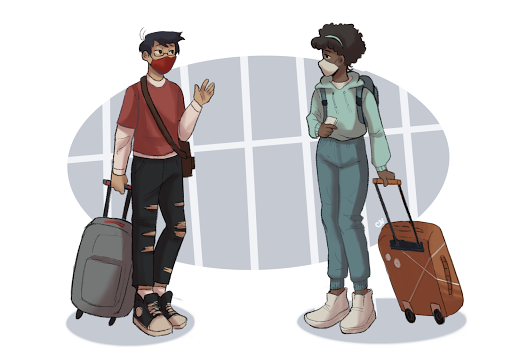Your donation will support the student journalists of The Tide, Richard Montgomery High School's student newspaper. Your contribution will allow us to purchase equipment and cover our annual website hosting costs.
COVID-19’s impact on the winter holidays
December 25, 2020

Due to COVID-19, celebrations of the winter holidays have differed from previous years.
Every winter as the year comes to a close, data consistently shows that a spike in viral disease transmissions mirrors the spike in holiday spirit. This year is projected to be no different.
In previous years, scientists have traced this seasonal increase to a variety of factors, both physical and behavioral. The shortened days typically result in less exposure to sunlight and Vitamin D, an important vitamin that powers the immune system and helps fight infection.
According to PLOS, the cold and dry weather is a more hospitable environment for the majority of viral diseases, which leads to higher virus survival and transmission rates. According to Medical News, the cold air can also cool the lining in interior nasal passages, slow mucus clearance, and remove an important microbial barrier between viruses and your body. The cold weather also causes people to spend more time indoors and instead come in close contact with one another, which fosters interaction and viral transmission.
The coronavirus is similar to the flu because they are both contagious respiratory illnesses. Laboratory experiments reveal that the virus has similar survival and transmission methods. PNAS research suggests that COVID-19 will follow the same seasonal activity trends as the year continues.
This year, the Center for Disease Control and Prevention (CDC) reported that regular seasonal influenza activity has decreased, likely as a result of standard COVID-19 precautions like mask-wearing, quarantine, and social distancing. As of Dec. 25, Montgomery County health metrics indicate that there are 43,454 total corona cases and 1037 deaths in the county. The seven-day average case rate is at 36.8 cases per 100 thousand residents, with a “very high” risk of transmission.
On Friday, Dec. 11, the first officially recommended COVID-19 vaccine was authorized by the US Food and Drug Administration (FDA). The vaccine was produced by pharmaceutical and biotechnology corporations Pfizer and BioNTech. Trials found an over 90 percent success rate in preventing the coronavirus among participants without any previous evidence of contracting the disease.
The vaccine is being used under an Emergency Use Authorization (EUA) from the FDA. Due to the limited size of the current vaccine supply, the CDC issued a recommendation that the initial vaccine supplies be offered to health providers and long-term care facility residents. According to the CDC website, “the goal is for everyone to be able to easily get vaccinated against COVID-19 as soon as large enough quantities are available.”
Once the vaccine is more widely available, CDC plans to have thousands of providers offer the vaccine in doctors’ offices, retail pharmacies, hospitals, and federally qualified health centers across the country. The vaccine will be free of charge, with exceptions for vaccination provider administrative fees.
Many people host parties, travel, or see family during the holiday season, but this year’s pandemic presents a challenge. States and counties have individual policies that may prevent people from crossing borders.
According to the CDC, travel is not recommended because of high-touch and close proximity locations like airports, bus stations, train stations, public transport, gas stations, and rest stops. At these locations, travelers are at risk of being exposed to the virus in the air and on surfaces. All travelers should quarantine for two weeks before leaving and get tested for COVID or quarantine for another two weeks after returning.
Regular social distancing recommendations also apply to seasonal gatherings. Celebrating virtually or with members of the same household poses the lowest risk for spread. According to CDC health guidelines, people should avoid in-person gatherings with family members or friends from different households.
CDC furthers that people should avoid indoor gatherings, especially in places with poor ventilation. Precautions that include limiting the number of attendees, wearing a mask at all times except when eating or drinking, and seating guests at least six feet apart reduces the risk of spread.
CDC recommends that party guests avoid singing or shouting, especially indoors and that any party music is turned down so people don’t have to shout or speak loudly to be heard. Hosts should encourage attendees to wash or sanitize their hands regularly, bring their own food and drinks, avoid potluck-style gatherings, use touchless garbage cans, and clean and disinfect high-touch surfaces and shared items.